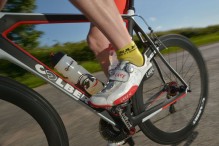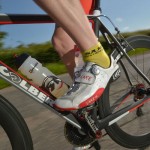Today, cycling is more than just fun. It’s an extremely efficient way to keep in shape and improve cardiovascular fitness. More than 100 million Americans still ride for pleasure on occasion. In New York City alone, 100,000 people cycle to work each day. Lance Armstrong, with 5 straight Tour De France titles in a row has brought cycling awareness and respect in the United States.
The Feet’s Link to the Pedals
Besides selecting a bicycle that meets your specific needs, proper shoes are the most important piece of cycling equipment. Cycling shoes must have a stable shank to efficiently transfer power from your feet to the pedals. The lack of shank support in sneakers allows the foot to collapse through the arch while pedaling, which may cause arch pain, tendon problems, or burning under the bottom of the foot. A rigid shank protects your feet from the stress of pedaling.
Investing in a cycling-specific shoe is a good idea if you have had pre-existing problems with your feet or wear orthotic shoe inserts. Most orthoses control the arch and heel, and for cycling, usually require critical forefoot balancing. Riders with mild bunions or hammertoes should select a wider, deeper shoe that will accommodate the deformity.
Select a shoe that’s right for you among models designed for racing and mountain biking. For the casual rider without known foot problems, cross-training shoes provide the necessary support across the arch and instep in a shoe that can be used for other purposes. They also provide the heel lift that cycling shoes give. Combination cycling-hiking shoes meet the needs of the casual rider well and have recently become popular.
The use of toe clips, and their degree of sophistication begin to separate the casual rider from the more serious devotee. Toe clips range from traditional clips to newer shoe-cleat ensembles — “clipless systems” — that resemble ski bindings. Many companies model their units on the French manufacturer Look. A Look-compatible unit will offer the most diverse combinations of shoes and clips from which to choose.
Proper shoes and clips or cleats working as a unit are important to achieve maximum efficiency in transferring power generated by the hips to the foot. For most efficient pedaling, shoes should extend fully under the ball of the foot.
Biomechanics and Cycling
Biomechanics, the study of external forces on the living body, plays a crucial role in efficient, satisfying cycling. For example, when seated on a bike with hands on the handlebars, the hands, shoulders, and front axle should all be in line.
By enhancing the biomechanics of the foot, podiatric physicians specializing in sports medicine can improve the mechanical functions of related body parts. If, for example, an experienced cyclist’s knees hurt after a 30-mile ride, the problem may be a biomechanical imbalance. A podiatric physician can alleviate the pain by correcting that imbalance through prescription orthotic shoe inserts. Training and conditioning methods should also be evaluated.
To preclude pain before it starts, podiatrists advise stretching the major muscle groups used in cycling — the gluteals, the quadriceps, calves, and hamstrings — before and after getting on the bike. Riders should start slowly and work up to normal cadence, or rate of pedaling. The seat is at the proper height when knees are slightly flexed and hips are over the knees.
Podiatrists recommend the use of a pulse monitor for a cycling-based training regimen. Some models strap around the chest, while smaller units wrap around the wrist or the thumb and display the pulse rate as you ride.
Ask your podiatrist about an appropriate pulse rate while you ride. Usually, the same criteria apply as with running: your pulse should be 60-70 percent of the maximum for efficient training.
Injuries and Treatment
Every day, podiatrists treat cyclists who have sustained overuse injuries by pushing themselves beyond their limitations. Here are some of the most common cycling injuries and their causes. As with all athletic injuries, pain that is persistent indicates a need to seek treatment from a sports medicine specialist familiar with cycling injuries.
Knee Pain: Some intrinsic knee problems like swelling, clicking, or popping should be immediately evaluated by a sports medicine specialist. Cartilage irritation or deterioration, usually under the kneecap, can be caused by a biomechanical imbalance, improper saddle height, or faulty foot positioning on the pedals. Riding in too high a gear, too far uphill, or standing on the pedals all may aggravate the problem. Cleated shoes or touring shoes with ribbed soles that limit side-to-side motion can cause knee pain if the knees, feet, and pedals are misaligned.
Shin Splints: Pain to either side of the leg bone, caused by muscle or tendon inflammation. This may be related to a muscle imbalance between opposing muscle groups in the leg. It is commonly related to excessive foot pronation (collapsing arch). Proper stretching and corrective orthoses for pronation can help prevent shin splints.
Achilles Tendinitis: Irritation and inflammation of the tendon that attaches to the back of the heel bone can be caused by improper pedaling, seat height, lack of a proper warmup, or overtraining. This condition is usually seen in more experienced riders and can be treated with ice, rest, aspirin, or other anti-inflammatory medications. Chronic pain or any swelling should be professionally evaluated.
Sesamoiditis: Sometimes known as the “ball bearings of the foot,” the sesamoids are two small bones found beneath the first metatarsal bones; the sesamoids can inflame or rupture under the stress of cycling. Sesamoiditis can be relieved with proper shoe selection and orthoses.
Numbness: Impingement of small nerve branches between the second and third or third and fourth toes can cause swelling that results in numbness, tingling, burning or sharp shooting pains into the toes. Wider shoes, or loosening toe straps or shoelaces can alleviate the problem. If the problem persists, try a clipless system.
Numbness or tingling with leg pain may represent a serious problem known as “acute compartment syndrome,” which requires immediate medical attention.


